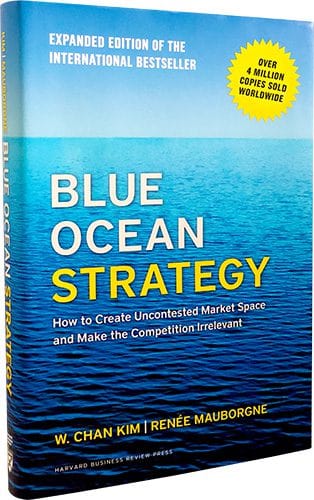BLUE OCEAN STRATEGY QUESTION & ANSWER
Chan Kim and Renée Mauborgne, the authors of Blue Ocean Strategy & Blue Ocean Shift, answer some of the most common questions they receive on blue ocean strategy from around the world. We hope these will be of interest to you too!

Questions About Blue Ocean Strategy
What motivated you to write an expanded edition of blue ocean strategy?
Kim & Mauborgne: Blue Ocean Strategy struck a chord with managers and executives around the world when it was published in 2005. Today, more than 4 million copies of the book have been sold and it has been translated into 47 languages, making it a bestseller across five continents. The term “blue ocean” has entered the business vernacular, and thousands of articles and blog posts on blue ocean strategy have come out, with more appearing daily. These articles explore how blue ocean strategy has provided the insight and the methodology for achieving high performance at low cost for individuals, businesses, or government organizations.
Through both our discussions and research studies with executives and managers implementing blue ocean strategy, we have been asked similar questions: How do we align all of our activities around our blue ocean strategy? What do we do when our blue ocean has become red? How can we avoid the strong gravitational pulls of “red ocean thinking” – we call them “red ocean traps” – even as we are pursuing a blue ocean strategy? These questions motivated the expanded edition.

What is new about the new edition of blue ocean strategy?
Chan Kim & Renée Mauborgne: The original Blue Ocean Strategy stimulated organizations around the world to pursue “blue oceans” of uncontested market space. The expanded edition of Blue Ocean Strategy brings all of the original case studies and examples up to date, expands one chapter, and adds two brand new ones. Together, the new material address manager’s key challenges and trouble spots in putting blue ocean strategy into practice.
For example, to aid organizations that have struggled to align their organizational activities, not to mention external partners, we lay out a simple method to get key components of an organization, from value to profit to people, working together to support the strategic shift blue ocean strategy requires. The new book also articulates our dynamic renewal process, one that helps companies make the creation of blue oceans a repeatable process and helps multi-business organizations balance both red and blue ocean initiatives.
Another key update outlines the ten most-common traps we see companies fall into as they apply blue ocean strategy in practice. Those traps – often created when companies embrace blue ocean strategy but interpret and try to apply its tools using more conventional conceptual models — keep companies anchored in the red even as they attempt to set sail for the blue. With the proper grasp of the concept, one can avoid the traps and successfully apply its associated tools and methodologies.

Why are so many CEOs focused on the red ocean, while as you’re claiming, the money is increasingly in the blue ocean?
Chan Kim & Renée Mauborgne: To sustain themselves in the marketplace, red ocean strategists focus on building advantages over the competition, usually by assessing what competitors do and striving to do it better. Here, grabbing a bigger share of a finite market is seen as a zero-sum game in which one company’s gain is achieved at another company’s loss. They focus on dividing up the red ocean, where growth is increasingly limited. Such strategic thinking leads firms to divide industries into attractive and unattractive ones and to decide accordingly whether or not to enter.
Blue ocean strategists recognize that market boundaries exist only in managers’ minds, and they do not let existing market structures limit their thinking. To them, extra demand is out there, largely untapped. The crux of the problem is how to create it. This, in turn, requires a shift of attention from supply to demand, from a focus on competing to a focus on creating innovative value to unlock new demand. This is achieved via the simultaneous pursuit of differentiation and low cost.
Under blue ocean strategy, there is scarcely an attractive or unattractive industry per se because the level of industry attractiveness can be altered through companies’ conscientious efforts. As market structure is changed by breaking the value/cost trade-off, so are the rules of the game. Competition in the old game is therefore rendered irrelevant. By expanding the demand side of the economy new wealth is created. Such a strategy therefore allows firms to largely play a non–zero-sum game, with high payoff possibilities.

What makes blue ocean strategy imperative in today’s business climate?
Chan Kim & Renée Mauborgne: Prospects in most established market spaces—red oceans—are shrinking steadily. Technological advances have substantially improved industrial productivity, permitting suppliers to produce an unprecedented array of products and services. And as trade barriers between nations and regions fall and information on products and prices becomes instantly and globally available, niche markets and monopoly havens are continuing to disappear.
The result is that in more and more industries, supply is overtaking demand. This situation has inevitably hastened the commoditization of products and services, stoked price wars, and shrunk profit margins. According to recent studies, major American brands in a variety of product and service categories have become more and more alike. And as brands become more similar, people increasingly base purchase choices on price. People no longer insist, as in the past, that their laundry detergent be Tide. Nor do they necessarily stick to Colgate when there is a special promotion for Crest, and vice versa. In overcrowded industries, differentiating brands becomes harder both in economic upturns and in downturns.
As products and services increasingly become commodities in overcrowded industries and companies’ profitable growth shrinks, companies are driven to compete principally on cost. One result of this has been the rising exodus of jobs to low cost countries like India and China as companies increasingly engage in outsourcing. While governments may seek to solve the issue of outsourcing through legislation, history teaches us that this is not a long-term solution. The long-term solution to creating jobs is in companies creating compelling products and services that take them out of the vicious cycle of commodity competition. This means moving companies’ products and services from the red ocean to the blue ocean. These issues alone make blue ocean strategy a rising imperative for CEOs.

Are you saying red ocean strategy is no longer useful?
Chan Kim & Renée Mauborgne: Absolutely not. It will always be important to swim successfully in the red ocean by out-competing rivals. Red oceans will always matter and will always be a fact of business life. But with supply exceeding demand in more industries, competing for a share of contracting markets, while necessary, will not be sufficient to sustain high performance. Companies need to go beyond competing. To seize new profit and growth opportunities they also need to create blue oceans. A better balance must be struck across red ocean and blue ocean initiatives.
Read next: What is Red Ocean Strategy and Why You Need to Shift to Blue Ocean

In your research, why did you choose “strategic move” as your unit of analysis instead of the popularly used company or industry? And how do you define strategic move?
Chan Kim & Renée Mauborgne: When we first asked ourselves if there is a systematic approach to create blue oceans, we began by looking at the basic unit of analysis used in business literature: the company. However, history reveals that there are no perpetually excellent companies. Consider In Search of Excellence, the first bestselling business book published in 1982. Within just five years two-thirds of the identified model firms in the book had declined. Likewise, for those sample companies in the book Built to Last, another blockbuster business book, it was later found that if industry performance was removed from the equation, many of the companies in Built to Last were no longer exceptionally excellent. As Foster and Kaplan point out in Creative Destruction, the companies listed certainly outperformed their markets, but so did their entire industries.
So if there is no perpetually high-performing company and if the same company can be brilliant at one moment and wrongheaded at another, it appears that the company is not the appropriate unit of analysis in exploring the roots of high performance. Likewise, there are no perpetually excellent industries. Consider IT. Five years ago people envied companies in that industry, today the reverse is largely true.
Our analysis of industry history revealed that the strategic move, and not the company or the industry, is the right unit of analysis for explaining the creation of blue oceans and the root of profitable growth. Our definition of strategic move is the set of managerial actions and decisions involved in making a major market-creating business offering. The strategic moves we discuss – moves that have delivered products and services that opened and captured new market space, with a significant leap in demand – contain great stories of profitable growth. We built our study around these strategic moves (over 150 from over 30 industries spanning from 1880 to 2000) to understand the pattern by which blue oceans are created and captured and high performance is achieved.

Is blue ocean strategy applicable to all types of industries including businesses that are several steps upstream from consumers?
Chan Kim & Renée Mauborgne: Yes, blue ocean strategy applies across all types of industries from the typical suspects of consumer product goods to B2B, industrial, pharmaceutical, financial services, entertainment, IT, and even defense. Blue ocean strategy drives this point home by highlighting a rich array of companies creating blue oceans across diverse, and unexpected, industry domains from NetJets in jet travel, to Cemex in cement, to Cirque du Soleil in entertainment.
Our experience further suggests two interesting findings with respect to businesses several steps removed from the final consumer. First, companies in these industries tend to view their businesses as commodity businesses with little room to offer innovative value. This has effectively created a self-fulfilling prophecy in that the more these companies view their businesses as commodities, the more they treat their businesses as such. Secondly, we observed that the more removed companies are from the final customer, the more levers there are to unlock innovative value as every company in that chain can be viewed as a customer.
If a company can’t see an opportunity to unlock innovative value for the next direct customer in that chain, there are still opportunities to unlock innovative value for that customer’s customers, and so forth.So if there is no perpetually high-performing company and if the same company can be brilliant at one moment and wrongheaded at another, it appears that the company is not the appropriate unit of analysis in exploring the roots of high performance. Likewise, there are no perpetually excellent industries. Consider IT. Five years ago people envied companies in that industry, today the reverse is largely true.
Our analysis of industry history revealed that the strategic move, and not the company or the industry, is the right unit of analysis for explaining the creation of blue oceans and the root of profitable growth. Our definition of strategic move is the set of managerial actions and decisions involved in making a major market-creating business offering. The strategic moves we discuss – moves that have delivered products and services that opened and captured new market space, with a significant leap in demand – contain great stories of profitable growth. We built our study around these strategic moves (over 150 from over 30 industries spanning from 1880 to 2000) to understand the pattern by which blue oceans are created and captured and high performance is achieved.

Is blue ocean strategy only intended for start-ups?
Chan Kim & Renée Mauborgne: Whereas blue ocean strategies create new market space and change industry dynamics, they are not necessarily initiated by new entrants to an industry. In our work, we looked back over 100 years of data on blue ocean creation to see what patterns could be discerned. We found that blue oceans were created by both industry incumbents and new entrants, challenging the lore that start-ups have natural advantages over established companies in creating new market space. In the auto industry, think of GM which created the blue ocean of emotional, stylized cars in the 1920s, or the Japanese which created the blue ocean of small, gas-efficient autos in the 70s, or Chrysler which created the blue ocean of minivans in the 80s—all were incumbents.
Moreover, the blue oceans made by incumbents were usually within their core businesses. In fact, most blue oceans are created from within, not beyond, red oceans of existing industries. This challenges the view that new markets are in distant waters. Blue oceans are right next to you in every industry. Issues of perceived cannibalization or creative destruction for established companies also proved to be exaggerated. Blue oceans created profitable growth for every company launching them, start-ups and incumbents alike.
Our findings are encouraging for executives at the large, established corporations that are traditionally seen as the victims of new market space creation. For what they reveal is that large R&D budgets are not the key to creating new market space. The key is making the right strategic moves. What’s more, companies that understand what drives good strategic moves—incumbents or start-ups—will be well placed to create multiple blue oceans over time, thereby continuing to deliver high growth and profits over a sustained period. The creation of blue oceans, in other words, is a product of strategy and as such is very much a product of managerial action, not the size or age of the firm.

Does blue ocean strategy hinge on new technologies?
Chan Kim & Renée Mauborgne: A company can create blue oceans with or without new technology. Think of Cirque du Soleil, [yellow tail], JCDecaux, or Starbucks. None of these blue ocean strategic moves depended on new technologies. Even in blue ocean cases that involved technology, Apple’s iPhone, Intuit’s Quicken, or Salesforce.com, their success hinged less on technology per se than on the fact that buyers find these offerings so simple, easy to use, fun and productive. So when technology is involved, it is key that you link it to value by asking: how does your product or service offer a leap in productivity, simplicity, ease of use, convenience, fun and/or environmental friendliness. Value innovation, not technology innovation, is what opens up commercially compelling new markets. Moreover, when companies mistakenly assume that blue ocean hinges on new technologies, their organizations tend to push for products or services that are either too out there, too complicated, or lacking the needed complementary ecosystem to unlock a new market.

Is a blue ocean offering necessarily the first mover in the market?
Chan Kim & Renée Mauborgne: Blue ocean strategy is not about being first to market. Rather it is about being first to get it right by linking innovation to value. One need only look to Apple here. From the iMac to the iPad, none of Apple’s breakthrough products have been the first in their category. But what they all successfully did was to link innovation to value. Organizations that mistakenly assume blue ocean strategy is about being first to market all too often get their priorities wrong. They inadvertently put speed before value. Corporate graveyards are full of companies that got to market first with innovative offerings not linked to value. Think about MITS, the company that created the first PC, or Ampex, first mover in the VCR market. Both laid the eggs only for other companies to hatch them. To avoid this trap, companies must remember that while speed may be important, linking innovation to value is absolutely essential. No company should rest easy until it achieves value innovation.

Are blue oceans attainable for everyone given that not everybody is born with a creative mind for innovation?
Chan Kim & Renée Mauborgne: Ever since Schumpeter wrote about the lone and creative entrepreneur, innovation and creativity have been thought of as a black box, unknowable and random. Not surprisingly, then, the field of strategy predominantly focused on analytic tools and frameworks to help companies compete in established markets. But is creativity a black box? When it comes to artistic creativity or scientific breakthroughs—Gaudi’s majestic art or Marie Curie’s radium discovery—the answer may be yes. But is the same true for the strategic creativity that opens up new market spaces? Think Ford’s Model T, Starbucks, or Salesforce.com. Our research, which revealed common strategic patterns behind the successful creation of blue oceans, suggests no.
Our very purpose for developing blue ocean strategy is to provide a set of methodologies and tools that can help managers pursue value innovation systematically and make blue oceans attainable for any aspiring organizations and individuals.
These patterns allowed us to develop underlying analytic frameworks, tools, and methodologies to systematically link innovation to value and reconstruct industry boundaries in an opportunity-maximizing, risk-minimizing way. While luck, of course, will always play a role, as it does with all strategies, these tools—like the strategy canvas, four actions framework, and six paths to reconstruct market boundaries—bring structure to what has historically been an unstructured problem in strategy, informing organizations’ ability to create blue oceans systematically.